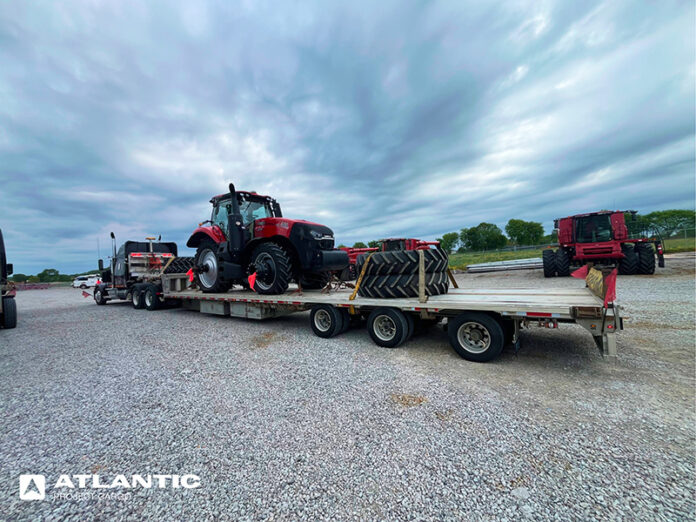
This article describes the transportation of different types of cranes, occurring challenges, methods of easy delivery, and important preparation steps. It also highlights later trends in crane import and export in the U.S.
Transportation of Different Types of Cranes
Here is a brief look at different types of cranes and the ways of their transportation to and from construction sites.
Lorry
A lorry crane can be transported by simply driving it to the required location. Built directly onto the chassis of a lorry, these cranes can reach construction sites using their own power. This self-propelling feature makes them easy-to-move, because they do not need additional transportation machinery. Once lorry cranes arrive at the destination, they are ready for immediate operation.
Mobile
As well as a lorry crane, a mobile crane is also capable of traveling on roads by itself, which allows it to be quickly set up at different job sites. Its ability to quickly access and navigate sites makes it an essential asset in the construction industry. Depending on their dimensions, certain mobile cranes may need special permits or escorts when traveling on roads, particularly if they exceed the standard height, width, or weight set by local or national transportation authorities.
Rough Terrain
Rough terrain cranes require transportation on large, heavy trucks. Their wheels are typically too large for normal use on public roads. That’s why they must be transported using specialized machinery. However, rough terrain cranes have self-propulsion capabilities, enabling them to cover short distances over rough or uneven ground to access remote job sites.
Crawler
Crawler cranes are necessary on construction sites because of their ability to move across difficult terrain. Their versatility and load capacity make them indispensable for large-scale construction projects.
When transporting over long distances, these cranes often have to be disassembled due to their weight and dimensions. Disassembling the crane for transportation and subsequent on-site reassembly significantly simplifies the process.
Crawler Telescopic
Crawler telescopic cranes are also transported in sections because of their dimensions. The on-site assembly process includes the installation of a telescopic boom and checking the readiness of tracks for operation. As mentioned above, disassembly will greatly simplify the shipping process.
For each type of crane, the method of transportation will depend on its size, weight, and distance to the construction site. Heavy-duty vehicles and detailed logistics support are necessary to ensure the safe delivery of equipment and its readiness to perform upcoming tasks. Atlantic Project Cargo offers reliable construction equipment delivery services, as well as crane transportation. Contact us and we will give you all necessary information.
Crane Disassembly
Disassembling a crane requires a qualified, experienced team and specialized equipment to ensure proper dismantling and functionality.
When disassembling a crane, each section is paid special attention to keeping it balanced. Components like pins, bolts, and pendants are released only once the entire section is properly rigged and balanced. Other cranes or equipment may be used to support the total weight during the process.
After disassembling the equipment, it may be packed into a container. Containerization of oversized machinery simplifies the transportation process, ensuring safe and cheaper delivery.
Specialized containers, such as Open-Top or Flat Racks, are designed to accommodate large-sized machinery, ensuring well-organized loading and unloading.
Atlantic Project Cargo can also help you with disassembly, container loading, and packing to ship your crane safely and securely even overseas.
Ensure the Crane is Ready for Shipping
It is important to make sure the crane is fully prepared for transportation beforehand. The preparation includes a number of procedures to ensure safety and compliance with transportation rules.
- Inspect the crane thoroughly. This includes checking for loose parts, securing all attachments, and ensuring hydraulic systems are free from leaks. Prior inspection will help identify any potential issues and fix problems before shipping.
- Arrange a disassembly if needed. The crane must be disassembled to comply with legal road transport dimensions. This often involves removing the boom, counterweights, and other components. Each part should be securely fastened to the transport machinery to prevent any movement during transit.
- Check out the shipping compliance, regulations, and restrictions. It is a crucial step, especially when you transport your crane to or from abroad.
Regulations for International Crane Shipping
Although the specific rules may vary from country to country, the following are general regarding the international transport of equipment:
- Export Controls: The importer must adhere to export control laws, e.g. the Export Administration Regulations (EAR).
- Import Regulations: Comply with import tariffs, taxes, customs clearance procedures, and safety standards.
- Transportation Regulations: Obtain proper documentation, comply with weight and dimension restrictions, and get insurance coverage.
- Technical Standards: To use the equipment abroad, it is necessary to comply with local noise requirements, safety and emissions standards.
Statistics on the Crane Export and Import in the United States
According to the Observatory of Economic Complexity (OEC) in July 2024, the export of cranes from the U.S. amounted to $41.4 million, and imports — to $155 million. It led to a negative trade balance of $113 million. From July 2023 to July 2024, crane exports from the U.S. increased by $7.21 million (21.1%) from $34.2 million to $41.4 million. Imports decreased by $-58.3 million (-27.4%) from $213 million to $155 million.
Cranes were exported mainly to Canada ($16.4 M), Mexico ($8.83 M), the Bahamas ($3.91M), the United Kingdom ($3 M) and Japan ($1.16 M). They were imported mainly from Japan ($39.5 M), Germany ($28.1 M), Austria ($21 M), Italy ($13.5 M) and Poland ($13 M).
The growth in annual crane exports was mainly due to increased exports to Canada ($8.01 M or 64.5%), Mexico ($2.03 M or 71.8%), and Jamaica ($1.92 M or 1.83k%). The decrease in imports was mainly due to lower imports from the Netherlands ($-1.79 M or -70.2%), Norway ($-1.57 M or -98.3%), and Canada ($-1.05 M or -16.5%).
Conclusion
Understanding how different cranes are shipped, what to do before their transportation and learning import and export regulations will ensure the cost-effective and safe transportation of your crane. To successfully transport it to the desired destination, don’t forget to reach out to Atlantic Project Cargo right now.



































